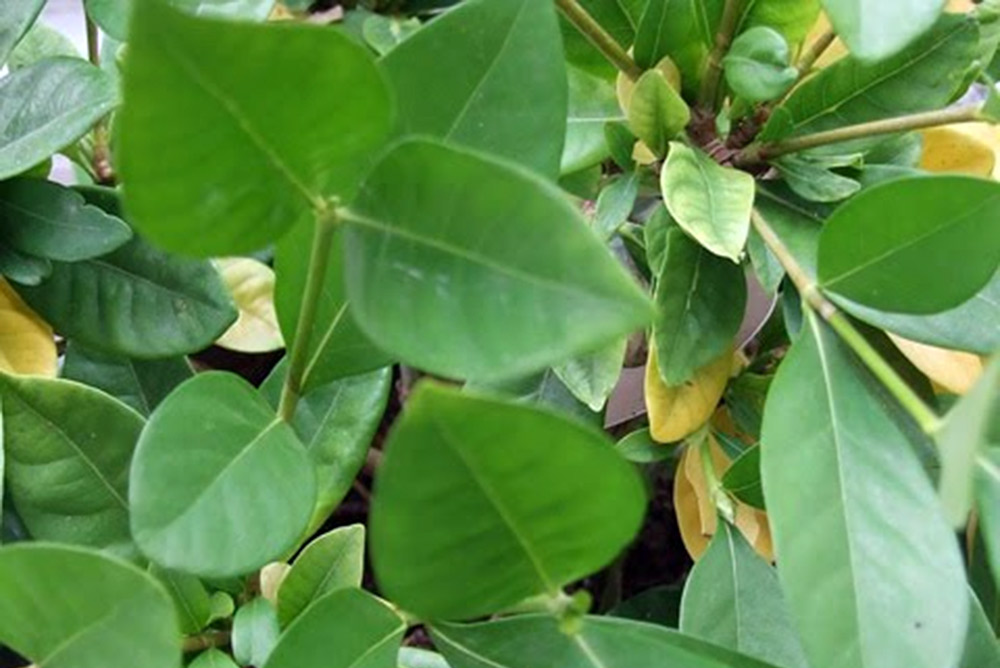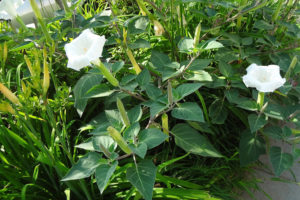
A few yellow leaves on the Cavanaugh gardenia, but it’s okay–they’re in the center. / Photo by Stephanie Cavanaugh. Photo on front from iStock.
MY GARDENIA has suddenly sprung a few yellowed leaves and since it is a nice big bushy specimen with several promising buds, I decided to care and Google the issue.
Digression. Isn’t it wonderful that you can now ask a question of Google in any peculiarly phrased way you wish, misspellings included, and come up with a few thousand . . . theories, if not correct answers? I’m sometimes curious about the people who torture the phrasing of their questions in the same way that I do. I’m sometimes curious about the people who even ask the same questions that I do, frequently with the same misspellings. What (frequently) demented path led them to wonder what they’re wondering and was it similar to mine?
Upon investigation, it turns out there’s probably nothing wrong with the gardenia (which, if you recall, is how we started out). Yellow leaves on the outside of the plant are disastrous for some reason that I don’t care about at the moment because mine are in the middle, where they’re yellowing because, as I discover, they’re just old. Like teeth. And they’ll die and fall off and be replaced by nice, new green ones. Unlike teeth. End of subject.
But in the course of this research I tripped across three suggestions for plant improvement that cost virtually nothing and don’t require getting in the car and driving to God knows where in Virginia. This is always a pleasant surprise: In fact these items are always in the house.
Epsom salts, also used for soaking The Prince’s old bones, is good for roses; and coffee grounds, also used for waking me up, apparently does the same for hibiscus; and rotten egg juice is said to be miraculous for just about everything.

A lovely trumpet vine; unfortunately it doesn’t belong to Gardener Cavanaugh, whose specimen might improve with the application of rotten egg juice. Ewwww. / Photo by Stephanie Cavanaugh.
Epsom salts, I’m reading, either diluted with water and poured about the rose or worked into the soil at the base of the rose, is said to promote branching, leafing and blooming. What more could you want! It has something to do with the chemistry and soil and stuff that makes me nod off like the dormouse while reading so here it is, from the Rose Magazine website (although we have politely fixed some of their spelling, grammar, etc.):
“Epsom salts are used to provide magnesium to the soil. Roses seem to be heavy feeders of this element. A soil test would be the only way to really know if your soil was lacking in magnesium, but most rose growers just apply a small amount per bush. You can sprinkle a couple of tablespoons around the rose, or dissolve it in a watering can first and water in. If you are using a balanced rose fertilizer that contains magnesium, it’s probably not necessary to add more. We tend to over-feed our roses at times. If your soil is light and sandy, feed more; if it’s rich or clay like, feed less.”
Public Service Announcement: I grow neither peppers nor tomatoes, but it is said that Epsom salts have a similar effect on both. Look it up yourself.
Now. Almost giving me the vapors is the notion that scratching coffee grounds into the soil around my hibiscus will promote flowers. First, because this house generates a steady stream of coffee grounds that otherwise land in the trash; and second, my hope for actual hibiscus flowers is suddenly revived.
My lack of success with the dozen or so hibiscus I’ve attempted to grow over the years probably has to do with the meager sunlight in the garden, a lack I attribute to My Prince encouraging my sudden and completely ill-considered notion to plant a kwanzan cherry tree in a yard more suited to a tall celery (does celery grow up or down? How does celery grow? This is interesting and will someday be investigated in a Google search). Why he goes along with my fancies I do not know, but he is frequently wrong to do so.
But a judicious sprinkling of coffee grounds around the base of the plants is said to provoke fabulous flowering. It is also said to inspire jasmine to bloom, and it might just be doing so—several what I suspect are jasmines, I really don’t know since they haven’t flowered in years, have set buds.
And then there is rotten egg juice, a fairly disgusting liquid that is made by tossing your breakfast egg shells into a canister, covering them with water, and then covering the canister tightly, for what will become an obvious reason. Let this brew steep for a week or so and the stench when the lid is popped is breathtaking.
I’ve heard it is effective for all manner of flowering plants, but I’m specifically using it to coax my recalcitrant angel trumpet—special-ordered for what are supposed to be its divine pale pink with green throated flowers, I think I recall—into bloom. In its third summer it stands pathetic in a gigantic planter at curbside, its skinny stalks dangling droopy foliage. The most it has done this year is drop a shriveled leaf or two. This is not at all the effect I was going for.
I suspect it just doesn’t like me, but we’ll know soon enough.
—Stephanie Cavanaugh
Gardener Cavanaugh is working on a book about urban gardening. To read her earlier columns, type “Green Acre” in the Search box at the top of the screen.

Don’t know about rotten eggs, but you prompted the memory (everything is distant lately) of coffee grounds. I will revive the practice for my trumpet plant (cutting given to me by Rose’s niece, Mary) which DID bloom once but nevermore. Thanks Gardener C.